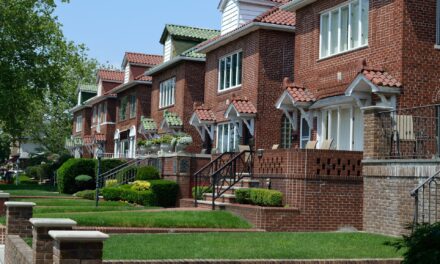Part II of this article series comments on the deterioration of suburbia in its current form and discusses the factors shaping suburbia’s future.
For a discussion of the coming depopulation of suburbia as the highly educated Generation Y and retiring Baby Boomers return to California’s urban cores, see Part I of this article series.
Poverty and crime
The Millennium Boom hit suburbia especially hard, as residents in suburban areas are disproportionally vulnerable to shifts in the broader economy as they lack adequate employment centers. Consider California’s largest centralized influx of population during the past decade, Southern California’s Inland Empire where a majority of jobs were related to the construction industry. As a result of the Great Recession, the Inland Empire currently has an unemployment rate of 14.8% and is currently still experiencing a net loss of jobs.
Without employment after the Boom, defaults soared and ghost towns were left. As of April 2011, the concentration of defaults were consistently higher in lower-cost suburban areas, with a ratio of 11 notices of default (NODs) filed for every 8 NODs for the rest of California. The increased vacancies in suburban neighborhoods has resulted in blight and increased crime. Much like the inner cities of the ‘60s and ’70s – known for high crime, gangs and poverty – suburbia will become the newest retreat (or jail) for California’s economically more desperate.
Suburbs now have the largest poor population in the nation, as reported by the Brookings Institute. Between the years of 1999 and 2008, the legion of suburban poor grew as much as 25%, five times the rate of the poor in urban areas. This trend mirrors the fall of Moreno Valley and the Lancaster area after the collapse of the economy in the 1990s when jobs failed to support the Boomers who had recently moved in. Just as short sales and distressed property sales became the norm in 1992-1997, the same trend continues today in newer subdivisions.
Crime in blighted suburban areas will similarly swell in future years as a massive swath of latch key children, raised by babysitters and the television, will come of age. The absence of parents while growing up, who were by necessity away from home in the centers of employment earning a living, will make itself known on a broader societal level as these children grow out of childhood. This in turn will further drive out the educated elite who will escape to the gentrified city. In their place, their sprawling suburban houses will be rented out to less savory, lower-income tenants or sold to owners (if the price is right), who will likely perpetuate the cycle.
Obsolescence and diminished social services
Schools and public services in suburbia will worsen. While the suburbs may have been cheaper in the short-term for suburban purchasers, numerous long-term hidden costs will present themselves. The suburban tax base – fed from new development and the rising property values which existed during the boom – will erode based on resale prices. The price cities pay for services do not erode.
Costs inherited by the suburban taxpayers will include:
- the cost of building and maintaining new freeways and mass transit options for those stranded in the suburban desert who must commute to earn a living;
- the long-term expense of cleaning up the environmental side-effects of suburbia’s encroachment into natural habitats and the steps taken to mitigate devastating wildfires in areas that were considered remote just years ago; and
- the cost of providing new amenities and social services to suburbia’s growing population of geriatric and lower-income individuals.
Similarly, physical deterioration will be increasingly problematic. The Golden Arches of the McMansions will lose their luster as the rapidly mass-produced properties constructed by national builders in distant locations will begin to show their age and poor construction materials.
Fuel prices and electric cars
Long commutes from suburbia to employment centers contribute to pollution and global warming, add precious hours to an already long workday, and perpetuate American reliance on imported oil. Simply, it is an unsustainable cultural habit compelled by urban sprawl and suburbia’s dependence on automobiles to function without a more centralized employment hub. [For more commentary on urban sprawl, see Part I of this article series.]
The average commute of an employed Inland Empire dweller has gotten longer in the aftermath of the Great Recession, according to 2009 Census data, as a third of the residents commute outside of the region for employment, such as to Los Angeles, and only 5% use public transportation.
People tend to put up with longer commutes during periods of economic turmoil, as they are unable to sell their homes and relocate, and are willing to drive further afield for any type of employment and the income needed to keep the family going. However, once jobs return, these death-march commutes will no longer be tolerated.
Fuel prices are higher than a commuter can justify – a reality that will only worsen with time. This condition will also encourage Californian suburbanites to relocate and live closer to their places of employment situated closer to the coast and large cities.
Is suburbia gone for good?
Does this mean that the McMansion stuffed culs-de-sacs will be bulldozed to the ground to make way for multi-family units? Can the private ownership interests tied up in a suburban neighborhood be unwound and the buildings unbuilt?
Despite the coming sea-change toward urban living, suburbia will not go the way of the dodo. Similar to a vestigial organ, it will lose its original function but not disappear entirely. Suburbia will be an appealing choice for those who value space and cost over the social and cultural allures of the city. Suburban areas in close proximity to employment opportunities in nearby cities, especially if they are connected via mass transit, will likely continue to garner the interest of future homebuyers.
The suburbs will also likely continue to house a large portion of California’s growing immigrant population. Hispanics currently make up more than 40% of the California population. From 2000-2007, the number of immigrants in Riverside and San Bernardino counties, mostly Hispanics hailing from Mexico, Central America and South America, leaped by more than half. However, this is changing too as Mexico’s greatly improving economy of 2011 is keeping more Mexicans at home, employed for the first time in their native country.
California will always need low-pay workers, native-born and otherwise, and these low pay workers will always need a place to live. The unskilled immigrant population with lower pay levels and their unskilled native-born counterparts will become the backbone of suburbia in the next couple of decades.
Due to their level of education and training, they cannot demand the high pay associated with professional urban jobs, but low-pay employment will still be available to them. These lower-income earners will need shelter in the new real estate paradigm, and suburbia will continue to offer a majority of California’s low- to mid-tier housing for them to occupy, with the exception of the very few low-income housing units provided in new developments for the inner cities.
Additionally, many of these lesser-educated individuals will not feel the same need to be in close proximity to areas of cultural significance – sites such as theaters, museums and the like – as they have not been inculcated from a very early age through education to appreciate such amenities. [For more information about immigrants and California real estate, see the January 2011 first tuesday article, Immigration’s impact on the housing market.]
To mirror the movements of the labor force, basic industry will also locate to low pay areas to cut their costs as they have done in the upper deserts of Los Angeles and San Bernardino Counties. Thus, suburbia and the outlying areas will experience an influx of light industry with labor intensive activities to fill up on cheap labor. The best paying jobs in these central California districts will be government employment, health care services and education.
Additionally, not all of Gen Y will flee to the “hip” allure of the cities. Though a majority of Gen Y may presently profess a desire to move to the cities when they are young and untethered by the three Ms (marriage, mortgage, maternity), it is unknown whether they will continue to hold this same aspiration ten to fifteen years hence when they are in a financial position to purchase.
Much like a thoughtless money-illusion, will the hip-illusion still entrance the members of Gen Y when they have the middle-age paunch, halitosis and a receding hairline? Or, like their parents, will Gen Y retreat back to the bastions of suburbia (now with family in tow) when homeownership becomes a financial possibility?
Though suburban landscapes will always be part of the California geography, their days of dominance are behind us. Thus, agents and brokers need to anticipate this massive demographic shift into urban areas, specifically multiple-housing projects with security and relatively high prestige. Take steps to prepare yourself now: starting 2016-2018, Gen Y and the Boomers will start to leave the long commutes, chaparral, sage and property maintenance of suburbia behind as they go to live where they work.















As prices of home ownership increases, mobile home parks and RV parks will become more popular.
Home Farms will be everywhere. Homes with out trees for food will be NON Sellers/
Trees and water on the land will be valuable in hard times…..Go plant trees…